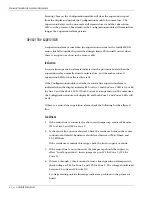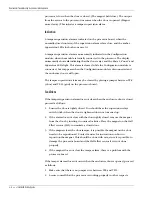
Maintenance/Troubleshooting - Supervision related problems
a - 4 • • • Intelli-FLEX II product guide
Pressing
Clear
on the Configuration module will clear the supervision report
from the display and unlock the Configuration module for normal use. The
Supervision Relays on the processor will remain closed, and the
Supervision
LED's on the processor board and on the Configuration module will remain lit as
long as the Supervision alarm persists.
Sensor line supervision
A supervision alarm occurs when the supervision current on the Intelli-FLEX II
sensor line falls outside the prescribed design limits. This usually occurs when
there is an open or a short in the sensor cable
Indication
A sensor line supervision alarm is indicated on the processor board when the
supervision relay, normally-closed contacts close, and the amber colored
supervision
LED for the affected line is lit.
If the Configuration module is attached, a sensor line supervision alarm is
indicated when the display indicates
L1
for Line 1 and the
Zone 1
LED is lit, or
L2
for Line 2 and the
Zone 2
LED. If both Zones are in supervision at the same time
the Configuration module will display
L2
and both
Zone 1
and
Zone 2
LEDs will
be lit.
If there is a sensor line supervision alarm, check the following for the affected
line.
Conditions
1. If the sensor line is connected, is the correct jumper cap removed? Remove
JP1 for Line 1, and JP2 for Line 2.
2. Is the sensor line open or shorted? Check the resistance between the center
conductor and shield. Resistance should read between 950 K Ohms, and
1.05 M Ohms.
If the resistance is outside this range, check the line for opens or shorts.
3. If the sensor line is not connected, the Jumper cap should be in place to
effect “Local Supervision”. Insert jumper cap on JP1 for Zone 1, (JP2 for
Zone 2).
4. If items 1 through 3 check out and a sensor line supervision alarm persists,
check voltage at TP4 for Zone 1 and TP5 for Zone 2. The voltage should read
between 2.2 volts and 2.8 volts DC.
A voltage reading outside this range indicates a problem on the processor
board.
















































